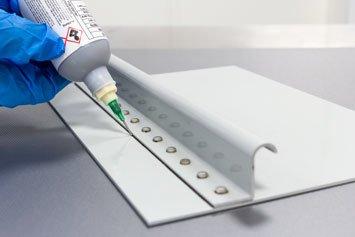Today there are a multitude of different sealing applications: Edge Sealing, Fillet Sealing, Cap Sealing or Interface Sealing for example. What applies in most cases, and is often seen in practice, is the following scenario: The operator with knowledge of the application uses the sealing material for the manual activity of sealing either premixed-frozen or 2-component cartridges. Standard 2-component cartridges (injection barrier cartridges) contain a pre-filled amount of resin and hardener. The mixing process causes resin and hardener to react in the cartridge and subsequently results in a total volume of the cartridge, e.g. 55 ml, 180 ml etc.
In many cases, however, this quantity is not sufficient. It is therefore not uncommon for half-full cartridges to be thrown away and the already cured material disposed of. The operator takes a new cartridge, the pot life starts again and before the material is used up, another cartridge is disposed of.
With a 180 ml cartridge, a pot life of 2 hours and an operator output of 42.5 ml/h, this results in a 95 ml material waste. In this case it equates to 52 %. The value, only shown here as an example, gives a very realistic picture from practice. In simple language, this means that every millilitre of material is actually twice as expensive.
An automated solution for maximum material savings
The good news is that this situation also offers a great deal of potential for reducing costs by saving on material waste.
With the help of ViscoTec’s automated solution, the two materials to be dosed can be purchased separately in larger containers and mixed as required. Two emptying systems remove component A and component B from these large containers. The 2-component dispenser vipro-DUOMIX mixes the two materials and doses an individually adjusted quantity into the cartridge. It ensures that only the amount of material needed at any one time is mixed and filled in.
Without changing the actual application technique (still carried out manually), the material can be individually mixed and dosed by means of a filling station. This not only reduces material waste but does so to a minimum. Purchasing conditions are also significantly improved through material procurement via large containers (e.g. 20 litre pail). In addition, both the logistical effort and the environmental impact are reduced. Simply put: More benefits and less effort without changing the overall process.
ViscoTec filling stations are always customized to the material to be dosed. High precision and gentle material dispensing are the key to meeting the high requirements of the aerospace industry and the specifications associated with it. Relevant tests and practical reports have proven this many times. There is no doubt that filling stations can also be used for materials other than those used for sealing.
Automation costs money. Automation is time consuming.
Automation is not worth it then?
Automation of a sealing process must always be considered and evaluated on a case-by-case basis. In most cases, however, automation can save a lot of money. By a comparably small change to the process.
It is time for a change, if it is profitable to do so.
ViscoTec – Perfectly dosed!
ViscoTec Pumpen- u. Dosiertechnik GmbH manufactures systems required for conveying, dosing, applying, filling and emptying medium to high-viscosity fluids. The technological leader headquarter is in Töging a. Inn (Bavaria). Furthermore, ViscoTec has subsidiaries in the USA, in China, Singapore and in India and employs about 200 people worldwide. Numerous sales partners all over the world complete the international distribution network. Next to technically sophisticated solutions to even the most complicated application, ViscoTec is the single point of contact to deliver all components for a complete system: from emptying to preparing and to dosing. This guarantees successful interaction of all components. All fluids showing a viscosity of up to 7.000.000 mPas can be conveyed and dosed almost pulsation-free and with extremely low shear. ViscoTec offers comprehensive consulting for every application and, if required, extensive tests will be carried out in close cooperation with the customer. The dosing pumps and systems are perfectly adapted to their respective application whether it is the food sector, the e-mobility industry, the aerospace field, the medical technology, the pharmaceutical industry and many other branches.
ViscoTec Pumpen- u. Dosiertechnik GmbH
Amperstraße 13
84513 Töging a. Inn
Telefon: +49 (8631) 9274-0
Telefax: +49 (8631) 9274-300
http://www.viscotec.de
Online & PR
Telefon: +49 (8631) 9274-404
E-Mail: melanie.hintereder@viscotec.de
